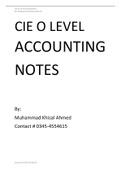Other
CIE O LEVEL ACCOUNTING NOTES (IGCSE Accounting Notes)
- Course
- Institution
IGCSE Accounting Notes Contents Accounting Equation...............................................................................................................................3 Ledger Accounts....................................................................................................
[Show more]



